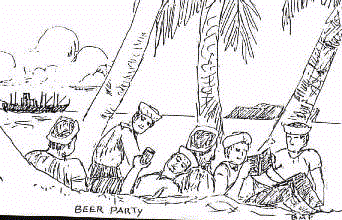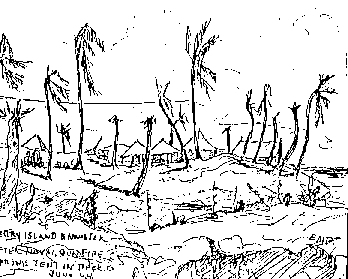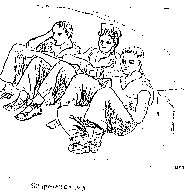"I soon found that Rainier was on what Capt Miller referred to as a "Pineapple Run". This consisted of loading ammunition at a depot called Port Chicago in an estuary of San Francisco Bay and then taking it to a depot in Hawaii called West Loch, loading Dole pineapple in cans in Honolulu and returning to San Francisco. I participated in two of these runs."
"Captain Miller was a tremendous man, a Tennessean, ... firm when necessary as well as kindly and fun-loving, an excellent seaman, a splendid ship handler with a knack for handling men. He once told me that 'loyalty comes from above... discipline from below'."
The Chief Engineer was Clyde Ault, a wizard with diesel engines. The Paymaster's name was Wetzel, a most peculiar, introverted, mild-mannered man looking like 'Casper Milktoast'. The First Lieutenant was my best friend. He was a small professional merchant mariner from the east, a King's Point graduate, Vince Bamford, a top-notch 'worry-wort'.

"The Navigator was "Swede" Hansen, a professional Navy man who had spent most of his life at sea, because when he went ashore, he couldn't pass up a bar. However, at sea, a most reliable man, rather ugly features with a lovely salty vocabulary.
The Bo'sun was Elmo Jenkins, a delightful red-headed pro who had once been with Admiral Byrd to the South Pole. Elmo was also fun-loving and fast with a quip..."
"We eventually learned we were going to Havannah Harbor, which is in the Southern Hemisphere in the New Hebrides, not far from Guadacanal. This was a long trip which Capt Miller made less boring by allowing everyone to grow beards and by having a big ceremony when we crossed the Equator."
"Havannah Harbor was a nice tropical place with a fine officers club behind which there was a horseshoe pitching court. Here there was an assortment of the finest Scotch whiskeys at 25 cents a drink... [Ed. Note- They were still 25 cents each in 1968 at Subic Bay] all at a time when stateside, we were limited to Three Feathers Bourbon and California Brandy. We had lots of fun there, but the fleet was moving rapidly up the Pacific and we had to keep up with them. The next few months were taken up with the island hopping campaign. A likely atoll would be chosen, the Marines and Seabees would go in meeting various degrees of resistance from the Japanese. When secure, we supply ships would go in, anchor and reservice the fleet. Some of the places were devastated by previous bombardment and some were very pleasant with adequate areas for recreation for both crew and officers.
 Eniwetok after Naval Bombardment
Eniwetok after Naval BombardmentIn one harbor in which we were anchored, we awoke to general quarters one morning, there being a report that a one man Japanese sub had slipped through the nets at night and was loose in the area. All day long, there was the 'WHUMP' of depth charges going off and people were getting very nervous, more so because floating swabs, with their handles sticking up like periscopes were adrift in the area. I think the sub was eventually sunk. In another harbor, we were watching a movie one evening when GQ sounded and we discovered we were under attack by Kamikaze planes. One hit the hangar deck of the Randolph, causing considerable damage and another hit the signal tower on shore, mistaking it for a ship.
 Five Inch Gun on the Fantail
Five Inch Gun on the Fantail"I had a .45 pistol issued to me. Although I had read the Geneva Convention stating that medical personnel should not be armed, I was told when I was issued it that that provision applied "...when fighting a civilized enemy." This is probably a legitimate attitude considering the Japanese atrocities reported at the time. On the other hand, I was told that the Intelligence Corps officers had to accompany the Marines to get "live" Japanese to interrogate."
"For a while, I was given the job of 'welfare officer' and during that period, I arranged with the Rainier Brewery to supply us with a considerable number of cases of beer to take with us for recreation parties for the crew. I censored mail and spent time with the Communications Officer, Tom Lennon, in the coding room. Tom was a wonderfully morose, cynical red-head whose main ambition was to beat the coding machine to pieces with a heavy hammer hung nearby for use only if we were captured.
"At one anchorage, an 'anchor watch' was set. This consisted of a man armed with a rifle guarding the anchor chain to prevent us from being boarded by that means. This day the guard was sitting in the gun tub, leaned over, at which time the rifle accidently discharged and his shoulders were sprayed by richocheting fragments of the bullet. He was not seriously harmed, but after that, the anchor watch was armed with a whistle."
Here's Steve McQueen in "Sand Pebbles", back when they trusted sailors with rifles, even "snipes". Click on the movie title for a great web page about the movie about the Yangtze Patrol.

[Editor's Note: As late as 1969, the anchor watch remained unarmed. During an anchorage in Hong Kong, I was fortunate enough to have drawn that duty. I was issued a rifle, a fine polished M1Garand, but no ammunition. I was given one of two options, (a) go below to the Gunners Mate shop and fill out a chit to request ammuniton be issued in the event some Red Chinese sapper should try to climb up the anchor chain, or (b) slug the varmint with the rifle butt. I was not issued a whistle, probably for fear its sound would be misinterpreted by the crew as the boatswains 'knock off' call. -W.Freeman]
Crewmembers on the Fantail
 Another picture of Dr. Davis and another of him , apparently on a "bad day" for a surgeon, actually a victim of King Neptune crossing the equator.
Another picture of Dr. Davis and another of him , apparently on a "bad day" for a surgeon, actually a victim of King Neptune crossing the equator.[Pictures of Dr. Davis courtesy of his son, Rob Davis, formerly EM1, USS South Carolina,](...to be continued)